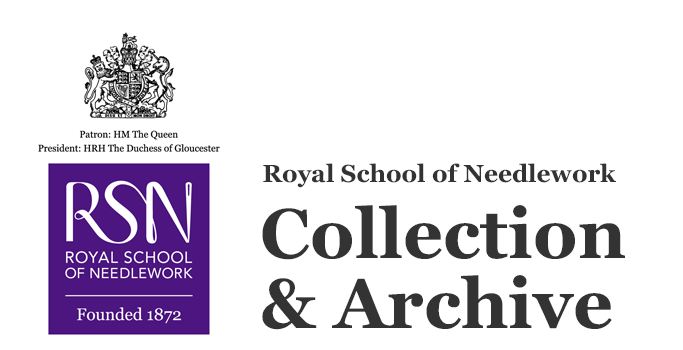Design Card
Date
1875-1922
Level of description
Item
Extent and medium
Dimensions 153mm X 245mm
Creator
Royal School of Needlework: Created by the Royal School of Art Needlework as miniaturised versions of designs. Original designs were miniaturised and either traced or copied onto 'Design Cards' which were sent out to clients for next day approval. This was part of the work of the 'Painting Room' sometimes referred to as the Paintroom, the department responsible for all design and draftsmanship.
Image, Selwyn (Rev): Selwyn Image (17 February 1849 – 21 August 1930) was a designer associated with the Arts and Crafts Movement. He designed across multiple media, and is particularly known for his stained glass windows, but also designed furniture, embroidery and illustrated books. He contributed designs over a number of years to the Royal School of Art Needlework. He was also the seventh Slade Professor of Fine Art at the University of Oxford from 1910 to 1916.
Image, Selwyn (Rev): Selwyn Image (17 February 1849 – 21 August 1930) was a designer associated with the Arts and Crafts Movement. He designed across multiple media, and is particularly known for his stained glass windows, but also designed furniture, embroidery and illustrated books. He contributed designs over a number of years to the Royal School of Art Needlework. He was also the seventh Slade Professor of Fine Art at the University of Oxford from 1910 to 1916.
Scope and content
Three design cards recording a Selwyn Image design for a piano front. Selwyn Image contributed a number of designs to the Royal School of Art Needlework (later the Royal School of Needlework). An Arts and Crafts designer, he worked across a number of mediums and is particularly known for his stained glass designs.
The design entitled Heard Sounds shows 4 children in a woodland including two trees and flowers: daffodils, lilies and possibly irises. The children are holding a banner with a John Keats quote 'Heard sounds are sweet but those unheard[are sweeter?].' the quote is from Keats's poem 'Ode on a Grecian Urn'. The children and the trees perhaps illustrate another line of the poem 'Fair youth, beneath the trees, thou canst not leave/ Thy song, nor ever can those trees be bare.' Keats's ambivalent poem on aesthetics from the Romanticism of the early 1800s would have appealed to the Aesthetics movement of the 1870s and 80s with its final line being "Beauty is truth, truth beauty,—that is all/ Ye know on earth, and all ye need to know." The text on the design invites those listening to the piano being played to ruminate deeper on art and life.
This piece is most likely to have been worked in outline in brown crewelwork like Selwyn Image's other figural designs for the RSN (see D1/003 & D1/005)
Annotated in pencil: Piano front S. Image
"Heard Sounds"
The design entitled Heard Sounds shows 4 children in a woodland including two trees and flowers: daffodils, lilies and possibly irises. The children are holding a banner with a John Keats quote 'Heard sounds are sweet but those unheard[are sweeter?].' the quote is from Keats's poem 'Ode on a Grecian Urn'. The children and the trees perhaps illustrate another line of the poem 'Fair youth, beneath the trees, thou canst not leave/ Thy song, nor ever can those trees be bare.' Keats's ambivalent poem on aesthetics from the Romanticism of the early 1800s would have appealed to the Aesthetics movement of the 1870s and 80s with its final line being "Beauty is truth, truth beauty,—that is all/ Ye know on earth, and all ye need to know." The text on the design invites those listening to the piano being played to ruminate deeper on art and life.
This piece is most likely to have been worked in outline in brown crewelwork like Selwyn Image's other figural designs for the RSN (see D1/003 & D1/005)
Annotated in pencil: Piano front S. Image
"Heard Sounds"
Transcription
Pencil Writing ' S Image' , 'piano front', "heard sounds " heard sounds are sweet, other wording illegible The card is printed Royal School of Art Needlework Exhibition Road South Kensington' at the top, 'Kindly return as soon as possible' at the bottom.
Reference code
D1/018.a-c
© Royal School of Needlework
